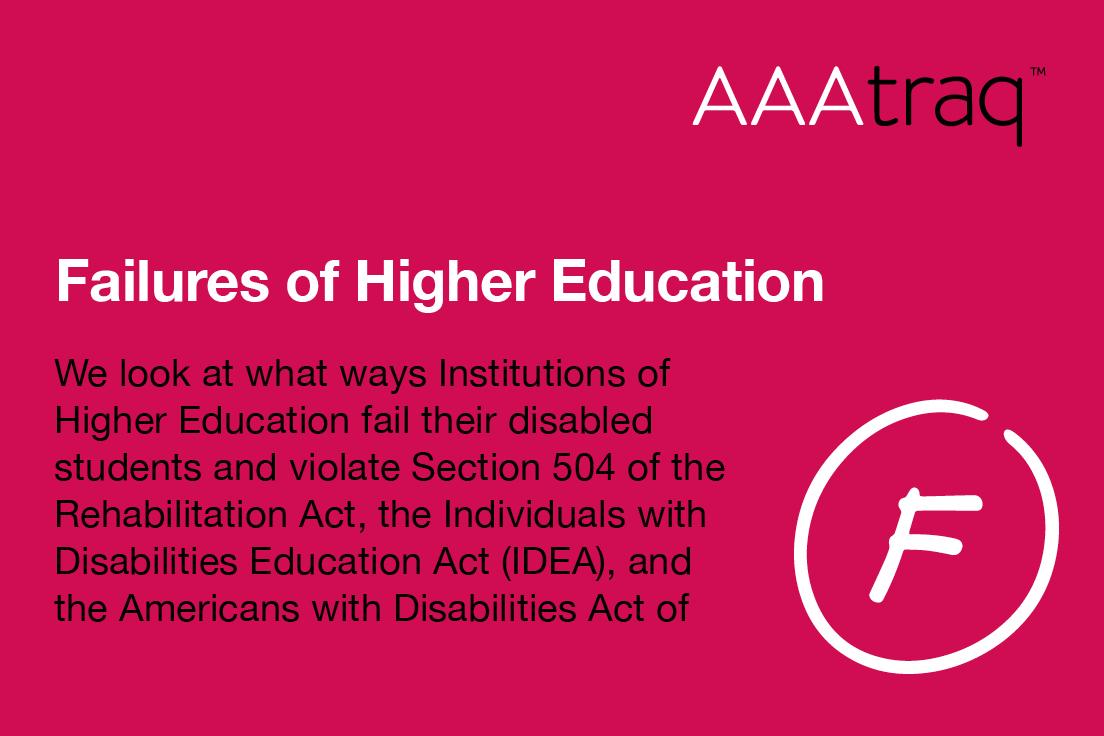Failures of Higher Education
Apr 14 2022
Institutions of Higher Education prove to be among the most progressive sectors in the current market when referring to disability policy.
While most schools are equipped to provide, at least, the bare minimum of accommodations to disabled students, the entire sector has proven to be deficient when it comes to providing digital accommodations to their users. As previously mentioned, AAAtraq’s “ADA audit finds 96% of Higher Education websites are not Inclusive and vulnerable to litigation” institutions of higher education need to do better in providing for a more accessible environment for disabled students. Of the 1767 accredited institutions for higher education that AAAtraq scored, 1705 of them have failed to be inclusive to disabled users. Such lack of inclusivity, and failure at website accessibility, has proven to be detrimental to the operations of an institution, and has led to a significant number of litigious claims.
Institutions of higher education are subject to the jurisdictional laws in which they operate. Such jurisdictions may include federal, state, and local laws. That said, those schools who receive any form of federal funding are subject to adherence to the anti-discrimination provisions towards web accessibility (and digital platforms) found in Section 508 of the Rehabilitation Act of 1973. Under Section 508 of the Rehabilitation Act, all electronic and information technology (EIT) that is developed, procured, maintained, or used by a federally subsidized agency must be made accessible to disabled users. Such statutory language prohibits the discrimination of individuals from technology based on disability status. Universities, particularly since the COVID-19 pandemic, rely heavily on virtual/digital platforms that must remain accessible to disabled users to avoid a discrimination claim. Furthermore, litigious claims against Institutions of Higher Education cite violations of Section 504 of the Rehabilitation Act, the Individuals with Disabilities Education Act (IDEA), and the Americans with Disabilities Act of 1990 (ADA). Such laws have served as the foundation for ensuring equity in education for disabled individuals.
Where and how do IHEs fail?
The ways in which Institutions of Higher Education fail their disabled students are as varied as the backgrounds of disabled students themselves. Not only are the externally focused websites of institutions inaccessible to students/webpage visitors, but the instructional materials utilized by members of the university community are not entirely accessible to the students who necessitate their use in the educational and residential process.
Third-Party Educational Platforms
Third-party software technology that utilizes the internet to deliver instruction often precludes individuals from having equality in access to all materials. Platforms such as Blackboard, Edmodo, and Canvas (along with many others) contract use of their technology to universities. Subsequently, the institutions license accounts to authorized users such as faculty, administration, and students to perform academic related activities (those required for instruction). Faculty uploads and facilitates much of the informational content available to the students (within the confines of the features available to them). Such information includes, but is not limited to, course syllabi, files used in the instructional environment, and accessibility/disability policies. As of now, much of the documentation is left inaccessible to users.
Why is this? First, and foremost, most of the time, faculty is unaware of their responsibility to ensure accessibility to their teaching materials (and more specifically, what that looks like in the digital/virtual realm). Faculty are not properly trained in what it means for a document/website to be accessible, nor how to make such documents accessible. Secondly, there appears to be an inherent disconnect in an understanding of the responsibilities for providing equity in access to information. Such disconnect goes beyond the faculty and lies predominately in a lack of understanding between the vendor and institutional administration. Most are unaware if the vendor is responsible, or the school is. Faculty have no knowledge of their role/place in confirming access to content. To ensure that your institution has a plan on how to address inaccessibility of these platforms, consult your vendor/licensing agreement and counsel. Check to see if you have an indemnification clause present, and who assumes liability for inaccessible content.
Residential/Student Life Applications
For individuals at institutions of higher education, academic life is only one pillar of the student experience. Institutions are responsible for the residential and student life components of the entire experience. What does that mean for ensuring digital inclusivity? Consider what aspects of student life rely on the digital sphere at your institution. Does your university offer a student life portal for use of social/organizational communication? Does your university require documentation to be signed or completed by students in order to gain access to specific content or residential spaces such as roommate agreements, space requests for organizations, and/or online surveys conducted by the university? How does one gain access into university related events? Is it through a portal, an online ticketing platform, or some other format? Does the university have forms posted on university websites that serve as a legal course of action (such as bias reporting forms and Title IX related processes)?
Every aspect of the student experience that engages with the student body (and other members of the community) on a digital platform is subject to the anti-discrimination provisions of legislative documents and the inaccessibility of said opportunities is actionable on behalf of the aggrieved party. Institutions must be proactive in remediating existing failures on their own platforms. Litigation cannot come about if no one is injured by your site. To ensure that your websites are accessible/inclusive, consider AAAtraq. AAAtraq encourages you to take 60 seconds to understand your own risk position – you can do it free at https://AAAtraq.com/check/ (opens in a new window)
Subscribe to AAAtraq and enjoy complete cover and peace of mind
